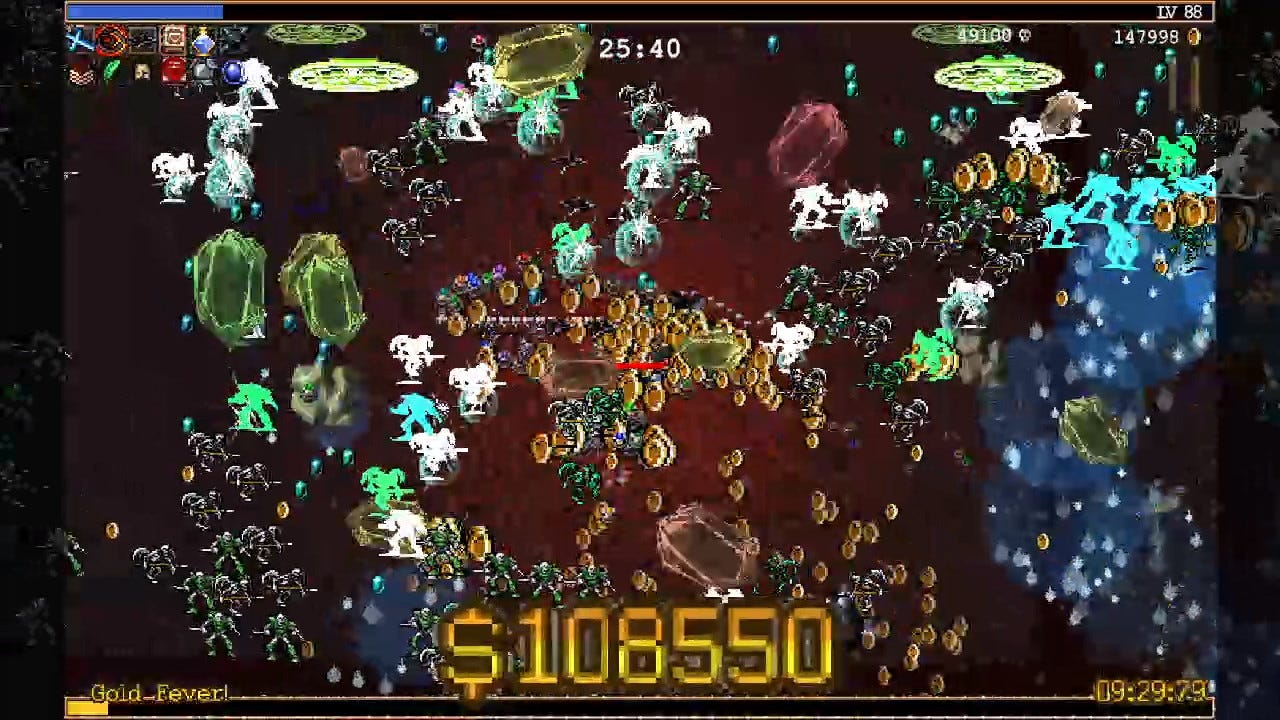Vampire Survivors + Ode to Castlevania DLC Review
All the Thrill of Gambling With None of the Bankruptcy
This game has been on my radar for a little while, but I was always skeptical that I’d enjoy it. Descriptions painted the picture of a game that mostly plays itself, and I’ve always preferred deeply involved moment-to-moment gameplay. Then, just as I was feeling bored and in need of something new on my Switch, leave it to an official Castlevania DLC crossover to push me over the edge of uncertainty. It’s literally four dollars - eight with that DLC which I’m definitely not skipping - so what’s the harm? Now all you aspiring developers out there know how to appeal to the “me” demographic: put Richter Belmont in your game. Thankfully, I found this game to be a surprisingly fun (and dangerously addictive) little diversion. More than a respectable effort from an indie developer who just wanted to make something fun, it’s a quaint reminder that there’s plenty of enjoyment to be had with the simple stuff, even if it occasionally ends up being a notch too simple.
The gameplay strikes an interesting balance of unbelievably straightforward control and pure chaos. All you really do is walk; the game handles everything else. Once you pick your character and the map, you’re plopped right in the middle of a wide expanse with your starting weapon as enemies start to close in from all around. You attack with all of your equipped weapons automatically, so all you have to do is move within striking distance of enemies, snatch up the EXP gems they drop, and move away from enemies you haven’t killed yet to stay alive. Leveling up lets you pick new weapons and passive stat-boosting items or upgrade the ones you have, which you’ll need to do to fend off the ever-growing hordes. Boss enemies with more HP drop chests when defeated, which either level up your equipment or evolve an equipped max-level weapon into something even stronger when paired with a particular passive item. No matter how you combine characters, weapons, items, etc., you can count on a strong run turning into screen-filling insanity as you near the end of the 30-minute time limit. Enemies spill in from all four sides of the screen as your weapons fire off constantly to repel them. Reaching this untouchable status for the first time provided the kind of primal joy unique to video games. True to the game’s Castlevania inspiration, quality sprite art and surprisingly awesome music flesh the experience out.
This is, undoubtedly, among the simplest forms of gameplay I’ve ever witnessed, but it does some clever things to keep players engaged at a basic level. Since movement is all you really control, there are smart ways to constantly encourage movement. The fact that enemies’ EXP gems and chests need to be picked up manually, even after leveling up your “magnet” stat a fair bit, creates an incentive to move even if the enemies can’t get close to you without dying. Where weapons aim often depends on movement, too; some attack either left or right depending on your faced direction, others attack the nearest enemy, and some can be aimed in a full circle around you based on movement. Furthermore, each map contains some goodies and secrets players have to make long walks to. Staying on the move makes keeping up with EXP difficult, but standing still means you’re not reaching potential targets, so you have to balance it out. Finally, luck, for all my gripes with it in game design, does help keep this game interesting. Aiming to get the items you need to combine for satisfying evolutions every level-up keeps you hungry for EXP gems. Thanks to unlockable options like skipping or rerolling level-ups or banning unwanted items during a run, you aren’t entirely at the mercy of the algorithm. All the same, those runs where everything breaks your way still have their foil in the runs where you just can’t get your hands on anything you need. The metric ton of unlockable content in this game also requires playing with nearly every single character, item, map, and so forth, so there’s plenty of incentive to mix things up a bit.
Ultimately, the weakness of a game like this is in its ability to be “solved.” With enough knowledge of which weapons and passives go well with each other and the flexibility to make the luck of the draw work for you, success comes consistently and without tension. Reaching that untouchable point earlier in a run means more time before the end where the game just presses on without anything engaging you in it. The game includes a lot of unlockable settings to stave off this effect, thankfully. “Hurry” mode cuts the time limit in half with a 25% boost to EXP gain, allowing for quicker - if somewhat harder - games. Other modes boost the difficulty, with “Hyper” speeding enemies up and “Inverted” making them more deadly and durable. Because the game essentially just boils down to math, though, all of these extra modes eventually become solvable too. Arcanas, when unlocked, allow the player to choose cards which enhance certain stats or weapons. Though building your run around these enhancements is fun, they’re also essentially the ticket to trivializing harder modes. Without more complicated mechanics for offense and defense, there’s no fun to tackling harder difficulties without these boosts; it just boils down to the numbers eventually. Learning how new unlocks work and meeting the challenge of higher difficulties and harder maps helps the fun last longer, but I find myself without much drive to keep playing now that I’ve unlocked almost everything.
Fortunately, DLC content like Ode to Castlevania can set you up with plenty of fun new things to work towards. Rather than just being legally-distinct Castlevania, this DLC gives Vampire Survivors a chance to really show some love to everything about Castlevania’s history. It’s the single most comprehensive Castlevania crossover and the biggest Vampire Survivors DLC yet, featuring 80 new characters and a trove of new weapons and evolutions. Though the game hits every note you’d expect from the most iconic games, no part of the series’ history (besides Lords of Shadow - not that I mind) is ignored. Characters from the maligned 3D entries like Castlevania 64 and non-canon games like Castlevania Legends are playable. Many bosses and random enemies from across the series are playable too, for some reason. Even Quincy Morris, the character from Bram Stoker’s Dracula who Castlevania uses as the father of Bloodlines protagonist John Morris, is playable. No, I’m not kidding. That’s real. Because characters are really just small sprite animations and various stat tweaks in Vampire Survivors, there was a clear opportunity here to include a ton of them which other crossovers didn’t have. That said, some characters like Alucard and most of the Belmonts even get the privilege of unique attacking animations with certain weapons. Over 50 new renditions of classic Castlevania music are included, too, all of which are very high-quality. Once again, some surprising choices are made here; there’s an absolutely fantastic remix of Moonlight Nocturne, the song which plays over Symphony of the Night’s opening crawl.

Not only does the Ode to Castlevania DLC reinvigorate the game with loads of new content, but the way you engage with most of it in Dracula’s Castle feels like a real evolution of Vampire Survivors’ gameplay. Whereas most of the maps are sprawling expanses with repeating layouts and little structure, Dracula’s Castle is split up into a host of unique areas. Each area has exclusive bosses to fight and items to find, all of which you’ll need to engage with if you want to work towards unlocking everything. As you unlock more and more of this map, you gain access to teleporters which connect the areas. Fitting as many goals as you can into a 30-minute stretch on this map, all the while not neglecting your EXP needs, presents more of a genuine mechanical challenge than simply cranking up the numbers does in the other challenge modes - and you can still activate all of those settings on this map. More than just extra content, Ode to Castlevania feels like Vampire Survivors coming into its own. The only downside is that the wealth of extra weapons can end up filling level-ups with items you may not want, which will give the banning functions a workout.
Overall, Vampire Survivors isn’t genre-defining or groundbreaking, but it is very easy to recommend. Anybody can understand how it works, it’s available on everything from PS5 to mobile phones, and it’s dirt cheap. Whether you get 8 or 80 hours of fun out of it - and it’s more likely to be the latter - you’ll have gotten your money’s worth. Plus, the developers are constantly working on new content, much of which is free, to keep making it a better experience. Like a bag of chips, Vampire Survivors is something easy to get your hands on that satisfies a simple craving.





